Suzuki's SV650 Takes on the Competition

Suzuki's 2017 SV650 Takes on the Yamaha FZ-07 and KTM 690 Duke
If you’ve read my 2017 Suzuki SV650 First Ride Review, you’ll know how I feel about the new SV. I’m a big fan of the new bike and feel that it’s recaptured the magic of the original SV. With its charismatic and refined 645cc V-Twin, I was instantly drawn to its fun-loving character, and now that Suzuki has wised up and given the bike an attractive – and competitive – $6,999 price tag, it’s clear Suzuki is answering the challenge thrown down from its crosstown rival, Yamaha, and the $6,990 FZ-07.
The two have a lot of similarities, with nearly identical price tags, twin-cylinder engines with similar displacements, and minimal bodywork. So naturally, it made sense to pit them against each other. However, as we were plotting the course for this test, another motorcycle came up on our radar screen: KTM’s 690 Duke. At $8,999, it costs a fair bit more than the Japanese bikes here, and its single-cylinder engine is only half the cylinders of the others, but it, too, can be classified as a naked middleweight so we decided to throw it in the mix. And for nostalgia’s sake, former MO staffer and current MO contributor, Gabe Ets-Hokin, was gracious enough to bring his 1999 Suzuki SV650 along for the ride to see how much progress the category has really achieved in the past 17 years.
Joining myself and Gabe was MO’s Editorial Director and former SV650 racer, Sean Alexander, and everyone’s lovable curmudgeon, John Burns. Three of us are unabashed SV sympathizers. Meanwhile, we tricked John into coming by telling him we’d have a Honda NC700X along for the ride. He really does love that thing. Sucker.
Let’s Get Right To It
Motorcycles like the SV and the FZ live and die by their engines. The bikes’ low price points are achieved through the use of bottom-bin parts, so manufacturers can focus most of its resources (read: money) on engine development. Because, in the end, an exciting engine will make up for many shortcomings in other places. Especially if the price is attractive. The SV and FZ are examples of what happens when a manufacturer gets this formula right.
If you remember from the SV video, I mentioned how the SV pumped out 72.8 hp and 46.0 lb-ft of torque. The Yamaha and KTM weren’t available yet at the time of that run, so in the interest of fairness we ran all three bikes together on the MotoGPWerks dyno, where the new SV spun the drum a second time to 70.8 hp and 44.9 lb-ft. While it was a little disappointing to see the minor drop in power, it goes to show how much dyno runs of the exact same bike on the exact same dyno can vary on different days and different times of day.
What was impressive, though, was the separation of all three bikes. Both the KTM and Yamaha made 69.8 hp at their peaks, resulting in a separation between the three bikes of exactly 1.0 horsepower. All three bikes made peak power between 8500 rpm and 9000 rpm, to boot. In the torque department, however, the SV falls behind, as it has the least displacement; the Yamaha made 48.0 lb-ft and the KTM 50.4 lb-ft. Making matters worse for the SV is the fact its peak torque is produced at 8100 rpm, while the KTM only needs 6900 rpm to reach its peak, and the Yamaha 6500 rpm. Gabe’s old SV never made it to the MotoGPWerks dyno, but it’s no matter since his bike may look stock on the outside, but features a number of modifications, including a jet kit for the carburetors(!) and a camshaft upgrade from the second-gen SV. Gabe estimates his bike makes somewhere in the ballpark of 68 hp.
When you’re sitting on them, you don’t need dyno charts to feel the power differences. Judged on its own, the new SV is a fun and lovable 645cc V-Twin, with crisp, clean fueling and just the right amount of punch. Gabe said the new SV “is so nice to ride, especially if you’re used to first- or second-gen SVs. Smooth, quick-revving and the intake growl sounds good.”
But then you hop on the KTM and remember that there’s no replacement for displacement. The 690cc Thumper makes more torque than the SV, only one less horse, and crucially, it weighs a massive 85 lbs less than the Suzuki. The KTM basically sheds the weight of a prepubescent teen compared to the SV, and thusly feels more powerful than the new Suzuki.
“This is a Single that feels like a Twin,” says Gabe. “It’s very nice down low and really fun when it gets to the top of its rev range.” Gabe also liked the KTM’s midrange.
The Yamaha, too, has a weight and cubic-centimeter advantage over the SV. It’s not 85 lbs lighter like the KTM, but a 33-lb deficit is nothing to sneeze at. Couple that with significantly more torque than the SV below 5000 rpm (and more horsepower below 8000 rpm), and the 689cc FZ-07 leaves the 690 Duke and both SVs behind once it’s time to get moving.
“Compared to the Duke and SVs, the FZ accelerates my large load with noticeably more urgency out of low-speed corners,” notes Sean “I Heart Pork” Alexander. “It simply has a better spread of torque for street use.” The parallel-Twin, and its 270-degree crank, sounds great but “it’s extremely quiet,” says Sean. “It could really use an aftermarket – or stock Aprilia – silencer.” Zing!
The three normal-sized testers had no complaints about the Yamaha’s fueling, as we thought it didn’t have anywhere near the jerkiness and abruptness of its larger-displacement sibling, the FZ-09 (before Yamaha updated its ECU tuning). Sean, however, felt Yamaha went too far, describing the “anti-FZ-09 throttle response… a little too smooth and seems to lag slightly behind wrist inputs, making it feel somewhat disconnected.”
That said, it should come as no surprise that the FZ-07’s inline-Twin won unanimously among the four testers on the MO Scorecard, its 93.1% rating besting the KTM’s 87.5% score. The new SV tallied 86.3%, and the old SV 84.4%.
Playing In The Hills
In the handling department light should make right, right? It should, but our testers are all over the board here. Indeed, at 345 lbs and the lightest bike in this test, the KTM was easy to flick around. The leverage provided by the wide bars helps to throw the bike wherever it’s needed. The suspension was firm and taut, at least according to Gabe and Yours Truly. In fact, the combination of the bars, suspension, and weight made the 690 Duke my favorite in the handling category of the scorecard.
Oddly, Sean called the suspenders too stiff, while JB wasn’t a fan of the amount of dive on the brakes and squat on acceleration, never truly feeling comfortable with the Duke. Then again, SA and JB were spoiled by the accessorized 690 Duke we flogged two years ago in our Middleweight Mashup Shootout. Nonetheless, despite lowering their expectations for this non-accessorized new 690, neither of these two were big fans of the KTM’s handling.
Then again, the KTM is the outlier in this test in many ways. Besides the fact it’s significantly more expensive than the rest, you’re also sitting more upright than the others, almost in a supermoto-type position.
“This is more like a street-legal supermoto racebike than a budget all-arounder,” says Gabe. “It rewards an aggressive and expert riding style, so probably won’t inspire confidence in new and intermediate riders like the SV or FZ will.”
There are also mixed feelings for the Yamaha. Weighing in at 397 lbs full of gas, its sub-400 weight is hugely impressive. It shows in the twisties, as the FZ-07 feels nearly as easy to toss and turn as the KTM. After hopping off the SVs (especially the new one) and onto the Yamaha, I jotted in my notes how the difference in weight during transitions is especially pronounced when riding them back-to-back.
Of course, the issue you face with $7,000 motorcycles is mediocre suspension components, and unless you’re riding on smooth pavement when you’re ripping in the twisty stuff, it’s easy to upset the FZ. “Suspension and chassis are the weak points here,” notes Gabe. “Gets out of shape (but kind of in a fun way) when you push it hard.”
Here’s Sean:
“Our test FZ gave me the same mixed responses between the front and rear suspension that I disliked the last time it was in a shootout. The impression it gives me, a fat and fast rider, is that the rider is placed a bit too far aft in relation to the center of the chassis, my extra heft resulting in a slight choppering of the front end and a general lack of cornering feel. I can ride through it and still go fast on the FZ, but it just doesn’t feel as “natural” compared to all the other bikes we’ve tested it against. Increasing rear spring preload didn’t seem to help the FZ’s front end feel during our first shootout, only making it rebound a little quicker and generally feel a bit less refined. I left it alone this time, but to be fair, the stock suspension was not at all designed for riders of my ilk.”
And now, John’s take:
“When I think back upon it to the days when we used to split hares among sportbikes, the less powerful ones always felt like they handled better. Guess why? You’re not going as fast. With its much greater low-rev lunge and 33 less pounds [compared to the SV], the FZ is lightening its front end more which could explain why its front end feels less planted. Though I agree slightly stiffer springs or maybe just thicker fluid wouldn’t hurt it. For me at my weight, no complaints. Maybe just little more rear preload to load the front a tad bit more. On that bumpy section, I rode [the SV and FZ] and they were both not so great. Both cheap suspension, but for me the FZ’s is tuned better. In fact I think it’s some of the most-dialed cheap suspension ever.”
Despite the suspension complaints, the FZ-07 was top pick on JB’s scorecard for handling, and was tied with the KTM on Gabe’s scorecard.
As for the two SV650s, things get a little interesting. It isn’t entirely an apples-to-apples comparison between the two, as Gabe’s 1999 SV has heavier fork springs, thicker oil, and 20,000-plus miles (oh, and a ZX-6R rear shock). However, the character from the chassis between new and old, aluminum frame versus steel frame, is so similar. Both change direction in one fluid motion, and both give the rider great connection to the road.
Really, the major difference being the added weight of the new bike – at 430 lbs, it’s about 20 lbs more than the first gen. Gabe notes, “The SV’s weight (heaviest here) made it feel old compared to the KTM and Yamaha, but it also felt smoother, more stable and more refined.”
That’s a statement both Sean and I agree with. Sean’s a fan of the chassis geometry, ranking the SV his favorite handling machine on the scorecard, and I liked how stable it felt leaned over. Call it the road-hugging weight compared to the others, but the new SV feels relatively planted on its side, even if the road is far from perfect. The Yamaha, while lighter and easier to flick, gets unsettled easily when you combine speed, lean angle, and a bump in the road.
A little bit of instability is something John’s able to accept. Burns, who’s never been much of an SV650 fan, calls the new SV old fashioned.
“I think it’s a great bike for carrying a lot of corner speed a la Lorenzo. I don’t like to ride that way on the street (even if I was able to) because of all the blind corners. I like to slow down for the corners and squirt out. For that, the FZ buries the SV.”
Out And About
As fun as all four of these bikes are in the twisty stuff, all also make great motorcycles for general commuting duties. As noted in my Top 10 Features of the KTM 690 Duke story, the Austrian’s seat is very roomy, which is obviously great for larger riders. But it’s also nice for taller riders, too “as long as you can live with a big Single on the freeways,” notes Sean. To that end, the “big Single” really wasn’t much of an issue to the rest of the testers, its dual counterbalancers doing a great job to cancel out vibes. There is slightly more buzz than the others at 80 mph and above, but you’d have to be riding them all back-to-back to really notice it.
The bars place you more upright (though you can rotate them within the triple clamp if you prefer a slightly different position), and the pegs are relatively low, so the rider triangle is ideal for commuters. However, I found this position to work against me on the highway. As there’s zero wind protection on the Duke, my chest became a sail while traveling 80 mph on the freeway. The others at least point the rider in a slightly forward bend, making it less tiring to fight the wind blast.
The new SV has the rider reach the furthest of all to grab the controls. In Suzuki’s quest to make the SV as narrow as possible, the fuel tank follows the contours of the frame. This narrow appearance is visually appealing, but Suzuki also fitted the SV with narrow bars. The combination of long reach and narrow bars doesn’t do the riders any favors when it comes to hustling the bike around. But if you’ve got a long torso and/or longer arms, this may be less of a concern.
Yamaha’s FZ-07 falls somewhere in between. The seating arrangement is compact in relation to the others, but that’s not necessarily a bad thing unless you’re big or tall. Only Sean fits that category among us. Gabe thinks Yamaha “made the seat too low and the pegs too high. When you’re sitting on it, it looks like somebody hacked off the front with a Sawz-all.” I didn’t mind it, and in fact Burns rated the FZ highest on his scorecard in the Ergo/Comfort category.
I had the FZ and the 1999 SV tied as my favorite. I liked the compact feel of the Yamaha, especially in the twisty stuff, but also didn’t mind it on the freeway, either. When it comes to piling on the miles though, the Goldilocks of the group, in my eyes, was the first gen SV. The reason is simple: the seat on Old Red had the most padding of any of the bikes here, by far. It’s like sitting on a pillow compared to sitting on planks for the others. Ultimately, the KTM got the highest overall score in the Ergo category, but these four testers are split as to their outright favorite.
Other Odds and Ends
All three modern bikes here have some sort of electronic dash display, including a gear-position indicator. However, they were all hard to read at a glance, especially in the harsh daylight sun. The KTM was particularly bad, as its beautiful TFT display is completely useless under the glare from the sun. Despite the fact the numbers on the 1999 SV650’s analog tach were peeling off, I think we all renewed our appreciation for a simple needle to tell us how fast we’re going and how fast the engine is spinning.
All four bikes easily surpassed the 40 mpg threshold, with the Yamaha getting an average of 54.4 mpg, followed by the new SV650 at 51.3 mpg, the old SV at 47.1 mpg, and the 690 Duke at 42.3 mpg. (EiC Duke spun several hundred miles solo on the KTM and averaged 60.8 mpg.)
Both the Yamaha and 2017 Suzuki have mediocre brakes at best, but they really aren’t that bad for the price. “Both have good brakes,” said Burns, “but I like using the FZ’s more. It seems to trail-brake better with more feel of the contact patch.”
By virtue of having the best specs in the braking department, the KTM with its 320mm disc and four-pot Brembo caliper easily won the this category of the scorecard. The huge brake and light weight of the bike meant stopping power was fierce. “Really great brakes,” said Gabe,”especially for a single disc. Nice bite and feel.” The KTM also benefits from being the only one with ABS.
The KTM wins by default in the tech department. It being the only one with riding modes (not that you really need them), ABS, and traction control.
Despite finishing last on scores, the first-gen SV was a hoot to ride, and thanks to Gabe’s tastefully chosen mods, it could hang with the other bikes just fine. Seventeen years of wear and tear have taken their toll on the SV’s appearance, but isn’t patina in style these days?
In The End…
As these tests usually go, there can only be one winner. But this is a case where the Scorecard decision doesn’t truly reflect how each rider feels. The KTM really took a blow in the objective section of the Scorecard because of its price, but clawed back a lot of ground by having the least weight and best power-to-weight ratio. And there were some categories where we clearly had to give it the best score, like brakes, tech and suspension.
In fact, the KTM finished first or second in nearly every category of the Scorecard except one – it finished a distant last place in the Instrument category for the terrible positioning of the TFT instruments display. Ultimately, with an 84.2% score, the KTM 690 Duke is the winner of this test. In reality, however, of the four, only Gabe’s scores align with this conclusion.
The Yamaha, however, came a very close second, 0.36 percentage points adrift. Sean, sticking steadfast to his SV devotion, is listening to his heart. Despite objections from his brain, which ranked the Yamaha number one.
“In total, I have to give the edge in refinement, power delivery, appearance and seat comfort to the FZ-07,” said Alexander. “That said, the new SV is the bike I’d actually buy. To me, the SV’s chassis geometry, friendly feel near the limits of adhesion, 90-degree V-Twin sound, and basic natural talent mean it stimulates the happiest parts of my brain.”
John, meanwhile, took this opportunity to smack talk the rest of the SV-loving fanboys and pledge his allegiance to the FZ-07.
“Sorry I don’t share the SV love, but for me that bike has been lackluster ever since Gabe’s bike. When I came to Cycle, we tore Latigo Road up on Honda Hawks, and I learned from those guys that a small bike is by far the best way to go down Latigo. For me the FZ-07 is the modern Hawk. I had to downgrade it in the tech for no TC, but the beauty of these bikes is 70 hp isn’t enough to need it. You can open the throttle on the FZ really early. If speed is the goal, I think I’d get to the Rock Store quicker on the FZ. The Duke is the one I’d want if we were going on dirt roads too; its saving grace is it’s a semi-Adventure bike.”
As for me, it looks like I need to eat a slice of humble pie. After gushing about the SV after coming back from its intro, this test proved to me that the Yamaha FZ-07 is the superior machine – though the KTM is a really close second. There really is no replacement for displacement, and the SV is unfortunately outpaced here. Its heft doesn’t do it any favors, either. In my first ride review I mentioned how the new SV has captured the magic of the original. I still stand by that. The problem is motorcycles like the FZ-07 and 690 Duke are simply better.
Suzuki’s SV650 Takes on the Competition Scorecard | ||||
|---|---|---|---|---|
| Category | 2017 Suzuki SV650 | 2016 Yamaha FZ-07 | 2016 KTM 690 Duke | 1999 Suzuki SV650 |
| Price | 81.4% | 81.5% | 63.3% | 100% |
| Weight | 80.2% | 86.9% | 100% | 83.5% |
| lb/hp | 80.3% | 86.0% | 100% | 80.3% |
| lb/lb-ft | 70.8% | 81.9% | 100% | 75.6% |
| Total Objective Scores | 79.1% | 84.1% | 87.8% | 87.2% |
| Engine | 86.3% | 93.1% | 87.5% | 84.4% |
| Transmission/Clutch | 82.5% | 85.0% | 83.8% | 73.8% |
| Handling | 85.0% | 87.5% | 85.0% | 81.3% |
| Brakes | 82.5% | 80.5% | 88.8% | 57.5% |
| Suspension | 77.5% | 76.3% | 80.0% | 66.3% |
| Technologies | 76.8% | 76.3% | 91.3% | 50.0% |
| Instruments | 78.8% | 77.5% | 52.5% | 90.0% |
| Ergonomics/Comfort | 80.0% | 80.0% | 82.5% | 81.3% |
| Quality, Fit & Finish | 76.3% | 83.8% | 83.8% | 80.0% |
| Cool Factor | 72.5% | 81.3% | 91.3% | 72.5% |
| Grin Factor | 82.5% | 91.3% | 86.3% | 68.8% |
| Gabe’ Subjective Scores | 85.6% | 87.7% | 91.3% | 74.2% |
| John’s Subjective Scores | 78.3% | 86.3% | 82.9% | 71.3% |
| Sean’s Subjective Scores | 77.9% | 79.6% | 77.9% | 75.0% |
| Troy’s Subjective Scores | 80.4% | 81.7% | 81.3% | 76.3% |
| Overall Score | 80.3% | 83.9% | 84.2% | 76.8% |
Suzuki’s SV650 Takes on the Competition Specifications
2017 Suzuki SV650 | 2017 Yamaha FZ-07 | 2016 KTM 690 Duke | 1999-2002 Suzuki SV650 | |
|---|---|---|---|---|
| MSRP | $6,999 – $7,499 (ABS) | $6,990.00 | $8,999.00 | $5,699 |
| Engine Type | 645cc Liquid-cooled, EFI, DOHC, four-stroke, 90-degree V-Twin, 4 valves per cylinder | 689cc liquid-cooled parallel Twin | 690cc Liquid-cooled, EFI, SOHC, four-stroke, Single, 4 valves per cylinder | 645cc Liquid-cooled, Carburetted, DOHC, four-stroke, 90-degree V-Twin, 4 valves per cylinder |
| Bore and Stroke | 81.0mm x 62.6mm | 80.0 x 68.6mm | 105.0mm x 80.0mm | 81.0mm x 62.6mm |
| Compression Ratio | 11.2:1 | 11.5:1 | 12.6:1 | 11.5:1 |
| Horsepower | 70.8 hp @ 8600 rpm | 69.8 @ 9000 rpm | 69.8 hp @ 8500 rpm | 68.0 hp @ 8750 rpm |
| Torque | 44.9 lb-ft @ 8100 rpm | 48.0 @ 6500 rpm | 50.4 lb-ft @ 6900 rpm | 45.7 lb-ft @ 7400 rpm |
| lb/hp | 6.10 | 5.70 | 4.90 | 6.10 |
| lb/torque | 9.60 | 8.30 | 6.80 | 9.00 |
| Transmission | 6-speed; multi-plate wet clutch | 6-speed; multi-plate wet clutch | 6-speed; multi-plate wet clutch | 6-speed; multi-plate wet clutch |
| Final Drive | Chain | Chain | Chain | Chain |
| Front Suspension | 41mm conventional fork. | 41mm Telescopic fork; 5.1-in travel | 43mm WP inverted fork; 5.3-in travel | 41mm telescopic fork, coil spring, damping rod (preload adjustable 2002) |
| Rear Suspension | Link-type single shock, preload adjustable. | Single, preload-adjustable shock; 5.1-in travel | WP shock absorber with Pro-Lever linkage; 5.3-in travel | Link-type single shock, preload adjustable. |
| Front Brake | Dual 290mm floating discs, two-piston calipers. ABS | Dual 282mm discs, 4-piston calipers | Single 320mm floating disc, Brembo four-piston caliper. | Dual 290mm floating discs, two-piston calipers. |
| Rear Brake | Single 240 disc, Single-piston caliper | 245mm disc, 2-piston caliper | Single 240 disc, Brembo single-piston caliper | Single 240 disc, Single-piston caliper |
| Front Tire | 120/70-17 | 120/70-17 | 120/60-17 | 120/60-17 |
| Rear Tire | 160/60-17 | 180/55 ZR-17 | 160/60-17 | 160/60-17 |
| Rake/Trail | 25.0º/4.1 in | 24° / 3.5 in | 26.5º/NA | 25º / 3.9 in |
| Wheelbase | 56.9 in | 55.1 in | 55.9 in | |
| Seat Height | 30.9 in | 31.7 in | 32.9 in | 31.7 in |
| Curb Weight (Claimed) | 430.0 lbs | 397 lbs | 345 lbs | 413 lbs |
| Fuel Capacity | 3.8 gal (3.6 gal CA) | 3.7 gal | 3.7 gal | 4.2 gal. |

Troy's been riding motorcycles and writing about them since 2006, getting his start at Rider Magazine. From there, he moved to Sport Rider Magazine before finally landing at Motorcycle.com in 2011. A lifelong gearhead who didn't fully immerse himself in motorcycles until his teenage years, Troy's interests have always been in technology, performance, and going fast. Naturally, racing was the perfect avenue to combine all three. Troy has been racing nearly as long as he's been riding and has competed at the AMA national level. He's also won multiple club races throughout the country, culminating in a Utah Sport Bike Association championship in 2011. He has been invited as a guest instructor for the Yamaha Champions Riding School, and when he's not out riding, he's either wrenching on bikes or watching MotoGP.
More by Troy Siahaan



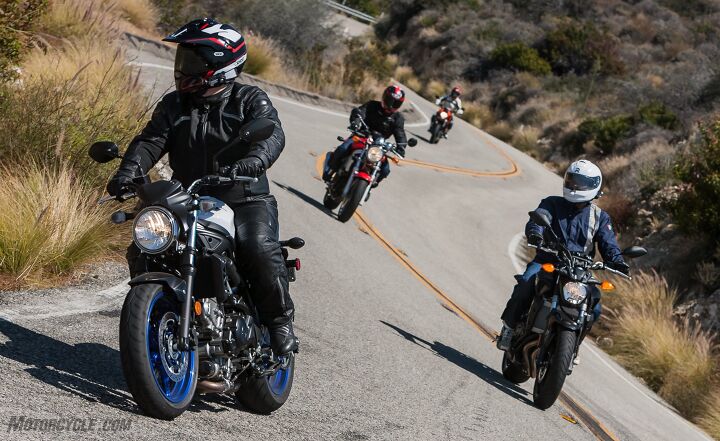
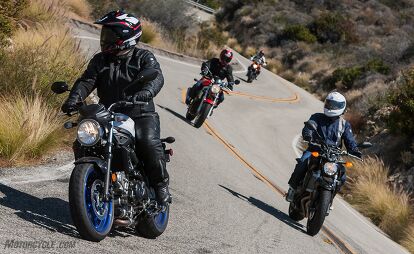

































































































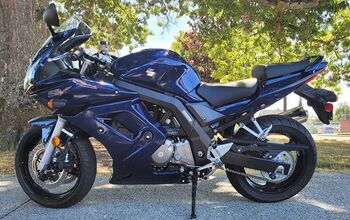
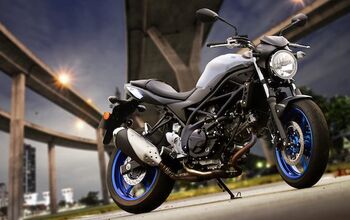
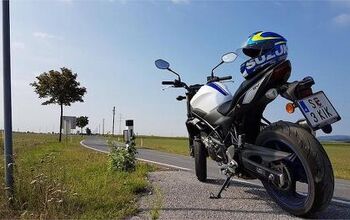











Comments
Join the conversation
WHY COMPROMISE ON WHAT YOU LOVE? MARRY THE PRETTY GIRL, BUY THE DUKE. I DID AND I WILL NEVER REGRET IT. YOU ONLY PAY FOR IT ONCE BUT YOU RIDE IT FOREVER. ECONOMY F**K THAT!!
I have shopped this new SV vs the FZ07 extensively. I've already owned two SVs and want this one. However, I am really put off by the weight. The Gen. 1 SV came in at under 400lbs and this is 430?! How is this progress? Who cares about the additional 5HP, just get rid of 30lbs and it will make the bike faster and "feel" a lot better in the corners. I'm bummed and doubtful I can pull the trigger on this one.